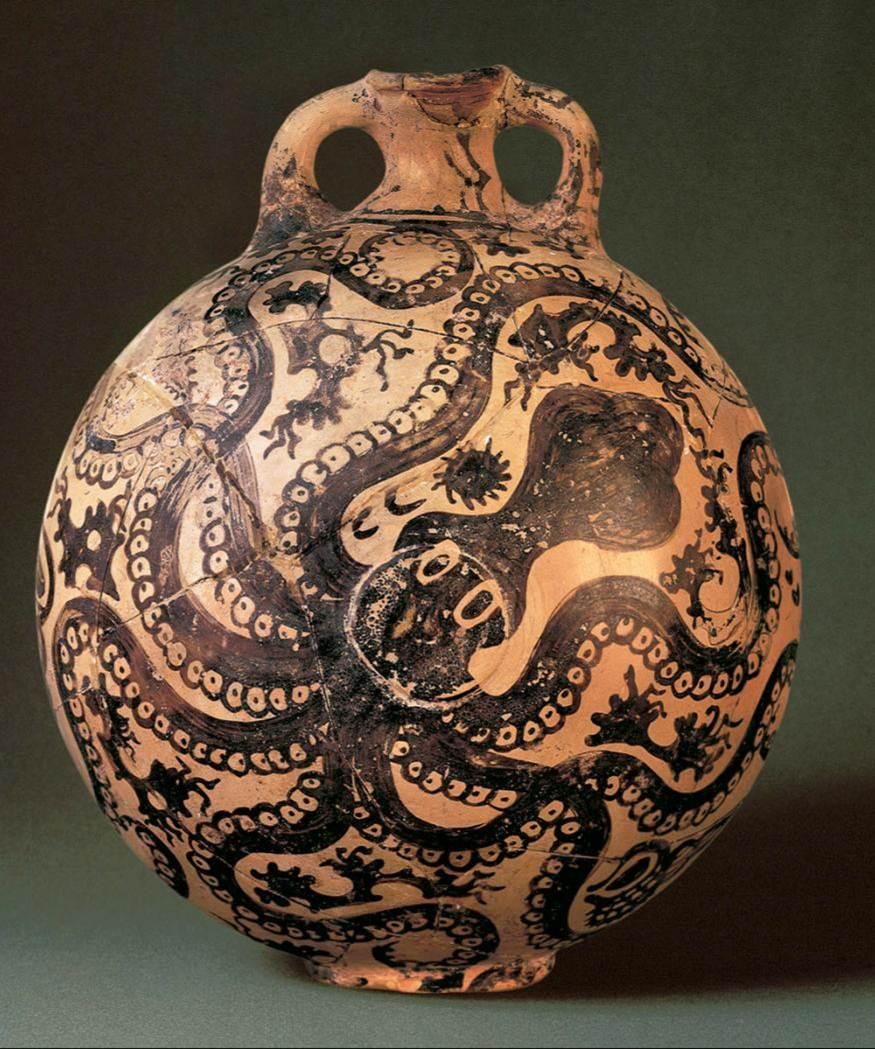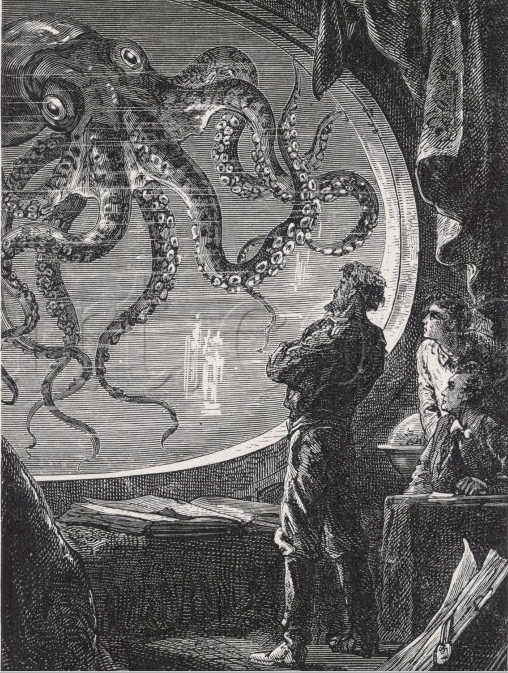Note to Alien Watchers: Octopuses are Marvelous, but Still Terrestrial
 Everyone agrees that cephalopods are fascinating, octopuses in particular. Apex marine predators, they hunt primarily by ambush and escape foes by water-jet swimming, mimicry, ink ejection and tentacle shedding (which they can regenerate, like lizard tails). Their niche dominance is buttressed by their ability to rapidly color-merge with their surroundings, squeeze through small openings (no bones or even the cartilage of cephalopod cousins) – and intelligence. They possess keen eyesight (their eyes evolved independently from those of vertebrates, as did those of insects) and chemoreceptors on their suckers allow them to taste what they touch, though their sense of shape is poor (more of that anon). Octopuses use tools, are known to play, may be capable of observational learning and are deemed so intelligent that they’re the only invertebrates almost universally protected from pain in research experiments.
Everyone agrees that cephalopods are fascinating, octopuses in particular. Apex marine predators, they hunt primarily by ambush and escape foes by water-jet swimming, mimicry, ink ejection and tentacle shedding (which they can regenerate, like lizard tails). Their niche dominance is buttressed by their ability to rapidly color-merge with their surroundings, squeeze through small openings (no bones or even the cartilage of cephalopod cousins) – and intelligence. They possess keen eyesight (their eyes evolved independently from those of vertebrates, as did those of insects) and chemoreceptors on their suckers allow them to taste what they touch, though their sense of shape is poor (more of that anon). Octopuses use tools, are known to play, may be capable of observational learning and are deemed so intelligent that they’re the only invertebrates almost universally protected from pain in research experiments.
Recently, the sequence of the octopus genome was published. This is an ongoing effort of gathering as many terrestrial genomes as possible, with the goal of figuring out the many black boxes still surrounding intelligence and emergence. The consensus of the genomes sequenced so far is that terrestrial life forms are as unique at the level of their genomic structure as at any other scale – yet the underlying common ancestry is also plainly visible. Of course, the PR departments of the teams doing the octopus sequencing had to figure out something to make that particular study stand out. Result: the numerous lay reports carried titles like “Don’t freak out, but scientists think octopuses might be aliens.”
I held my peace and tongue until I read the original paper itself. My verdict from reading it – which, incidentally, coincides with that of its authors – is that the octopus genome is as marvelous as its owners, and as unique as that of any other organism. However, it falls squarely within parameters in terms of structure and the organism it helps produce is therefore as terrestrial as anything else that moves on earth. So what allowed the churnalists to indulge in the customary hype? Well, primarily ignorance of basics such as the dynamic nature of genomes and the many alternative paths by which they generate complexity.
One fact touted as “amazing” was that octopuses seem to have more genes than humans (~35K versus ~22K, respectively) and the number doesn’t arise from a wholesale duplication, as it does in some insects and plants. However, there’s an immediate solution to that seemingly Gordian knot. It’s called alternative splicing. Alternative splicing (henceforth AS) is THE primary contributor to proteomic complexity and allows production of many proteins that vary in structure and function from a single gene. Some human genes produce hundreds of final products by this method, which then get further variegated by post-translational processes like phosphorylation and glycosylation (full disclosure: I spent my entire science career researching alternative splicing in the human brain and will be unmoved by arguments that “it’s mostly non-functional junk”). The AS mechanism is nearly universal in human genes but extremely limited in octopuses which instead use an on-off gene product modulation mechanism called RNA editing (ADAR). All eukaryotic species use varying ratios of AS and ADAR. Octopuses just happen to be mostly on the ADAR end of the spectrum.
Churnalists also presented two items as independent that in fact correlate: the octopus genome is rich in transposons (elements that allow genes to move around)… and gene families that arose as a result of duplication, which are most often tandemly organized, are dispersed in octopuses. Transposons are abundant in many other species (Barbara McClintock first documented them in maize, though the groundbreaking discovery took nearly four decades to gain her the Nobel she so richly deserved) and organisms with high numbers of transposons in their genomes inevitably show significant levels of gene mobility.
The cephalopods did not evolve just eyesight by a different path than that taken by vertebrates. The same is true of their nervous system, which is one reason why they’ve long been used for comparative studies in neurobiology and intelligence. Yet another point of hype was that octopuses appear to have more neurons than mice and have vastly expanded member numbers of two gene families involved in neuronal regulation. But as with the high gene count, there’s an interesting but non-exotic explanation for these findings as well. Namely, cephalopods need to coordinate their neuronal feedback loops locally unlike vertebrates, which depend on brain coordination.
Vertebrates have fast neuronal responses in large part because the myelin sheaths that wrap sausage-like around the neuronal axons allow what is known as saltatory conduction through the Ranvier nodes (the gaps between myelin sheaths). The loss of this propagation method is what creates most of the debilitating outcomes of such hereditary diseases as Tay-Sachs and Gaucher and the adult agonies of demyelinating diseases like Multiple Sclerosis and Tabes Dorsalis. In contrast, cephalopods don’t have myelin sheaths; the propagation of their neuronal impulses is linear which means it’s relatively slow (they also require large-diameter axons, which is one reason why these species were used as models in neurobiology research). In turn, the slow conduction requires local regulation of neuronal responses if octopuses want to remain predators instead of prey. Hence the large number of neurons and quasi-unique neuron-regulatory proteins.
So in this process, vertebrates opted for speed and integration; cephalopods for numbers and local autonomy. The locality of this coordination also means that, unlike vertebrates, octopuses have no integrative brain map. So, for example, they can minutely “taste” something within their tentacles, but cannot form a view of its overall shape. Not are they aware of the position of their tentacles, though each tentacle knows what it’s doing, so to speak. An eerie but non-mystical result of this is that a severed octopus tentacle will exhibit reflex behaviors for a while after it’s severed. But again, this is nothing exotic; it’s local autonomy at work, until degradative processes neutralize it.
The other side of this coin is that octopuses will never suffer from phantom limb pain or fibromyalgia, syndromes caused by disjunctions between a body and its brain map. The lack of integrative maps puts some limits to large-scale undertakings by aspiring octopus overlords, Hokusai’s famous Tako to Ama aside. So does the fact that octopuses die after procreation like salmon – males after mating, females after their egg sac matures. Their intelligence is individually based and they have no culture transmission, each octopus reboots de novo. Undoubtedly, their thought processes are alien. But – as I discussed in “Are We Not (as Good as) Men?” – so are those of chimpanzees, uplift or not.
 I fully expect to hear theories that octopuses may be like Larry Niven’s Pak: aliens trapped in axolotl-like neoteny because earth lacks a vital ingredient that would allow them to transition into adulthood (there’s also a Polynesian myth that posits octopuses as the sole survivors from a previous universe cycle). However, the octopus proclaims its terrestrial provenance at all scales. What its genes and neurons do illustrate, unequivocally, is the near-infinite variety of solutions to common problems. Or, as another “alien” (who’s actually all too human) would say, Infinite Diversity in Infinite Combinations.
I fully expect to hear theories that octopuses may be like Larry Niven’s Pak: aliens trapped in axolotl-like neoteny because earth lacks a vital ingredient that would allow them to transition into adulthood (there’s also a Polynesian myth that posits octopuses as the sole survivors from a previous universe cycle). However, the octopus proclaims its terrestrial provenance at all scales. What its genes and neurons do illustrate, unequivocally, is the near-infinite variety of solutions to common problems. Or, as another “alien” (who’s actually all too human) would say, Infinite Diversity in Infinite Combinations.
Related Articles:
Neanderthal Genes: The Hidden Thread in Our Tapestry
You Only Find What You’re Looking For
Miranda Wrongs: Reading Too Much into the Genome
”Are We Not (as Good as) Men?”
Floating Brains and Invasive Minds
The Price of Threescore Years and Ten
Images: 1st, Minoan clay jar, New Palace period (~1500 BC, Irákleion Museum); 2nd, depiction of a vertebrate neuron with its myelin sheath; 3rd, Captain Nemo and his guests contemplating a rival intelligence in Jules Verne’s Twenty Thousand Leagues under the Sea (illustrations by Alphonse de Neuville and Éduard Riou).



Nicely explained!
(You have an, um, interesting typo in the first paragraph, by the way.)
Glad you liked!
Whoops! I was so busy getting the apostrophe right that I didn’t notice the inversion (embarrass). Fixed now, thank you for the pointer.
I particularly liked the clear exposition of the difference between vertebrate and cephalopod nervous systems and the consequences thereof.
Hmm. Now I am thinking of sfnal story ideas (not octopi-as-aliens)….
Cephalopods were clearly able to evolve well enough to build starships according to Galaxy Quest. :^)
And do not forget these guys….
https://farm8.staticflickr.com/7721/17255193595_fea94a8929_o.jpg
Galaxy Quest is an anecdotal info source at best! But if there were a long-lived cephalopod variant that didn’t die after a single reproduction bout, I could totally see them becoming bio-based tech adepts.
Is that JPG a War of the Worlds illustration, Larry?
Athena, are you saying Galaxy Quest was just a movie?! :^)
About the War of the Worlds artwork, my apologies for not posting a link to the source. Amazing stuff here:
http://monsterbrains.blogspot.com/2015/04/henrique-alvim-correa-war-of-worlds.html
Quite fascinating!
Yes, each life form is astonishing in its inventiveness at all scales!
A few years ago a “documentary” came out describing future evolution.
http://www.thefutureiswild.com/ The main takeaway is not specific “predictions” but rather the at-first-glance surprising twists and turns evolution can take, especially after a mass extinction as organism radiate into suddenly empty niches. The creators of this mock series clearly had a fondness for cephalopods, as they dominate several future niches. Of particular interest are the air breathing, arboreal “squibbons” (squid-gibbons) who swing nimbly from tree to tree. The series ends suggesting that squibbons might form the ancestors of the next intelligent species on Earth. (Humans are absent, and their absence never explained.)
A major bottleneck for squibbons is that cephalopods use hemocyanin instead of hemoglobin as an oxygen carrier. That system works well in water, but poorly in air.
Ah, I was too ill-informed to see that problem. Their “future evolution” have other potential issues: fish evolve into flish, the dominant flying species (while birds go into the water and then die out), which I suspect is difficult without developing some sort of hot-blooded metabolism (but here I’m ignorant too). My guess is the producers were interested in the most twisty story they could devise.
Agreed. I think they also wanted odd/catchy visuals. As you say, it looks like the program was primarily for assumption-jiggling value.